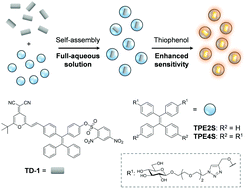Thiophenol detection using an AIE fluorescent probe through self-assembly with TPE-based glycoclusters†
Abstract
We describe a novel green-emitting tetraphenylethylene-dicyanomethylene-4H-pyran (TPE-DCM) based fluorescent probe (TD-1). Conjugating TPE and DCM moieties allowed TD-1 to display high selectivity for thiophenol with excellent AIE properties in aqueous solution. Nevertheless, the poor water solubility of the hydrophobic structure resulted in a weak and unstable emission intensity. The non-covalent self-assembly of TD-1 with a TPE glycocluster (TPE2S) led to a largely improved water solubility producing a reliable and stable sensing system. The corresponding glyco-probe could sensitively detect exogenous thiophenol concentrations in PBS buffer or environmental water samples.



 Please wait while we load your content...
Please wait while we load your content...